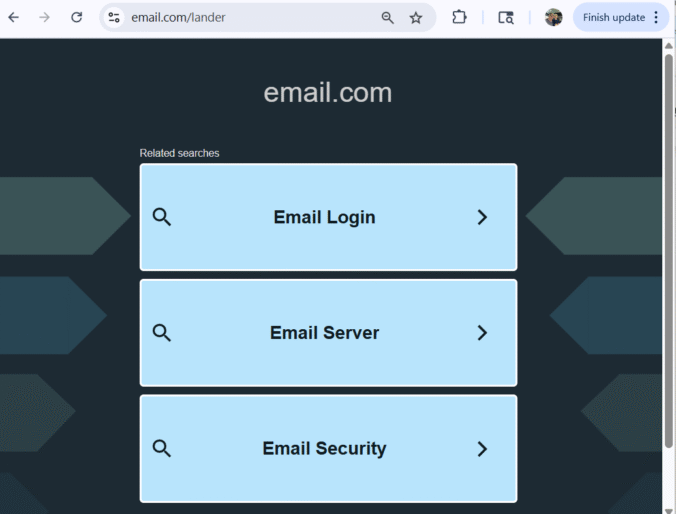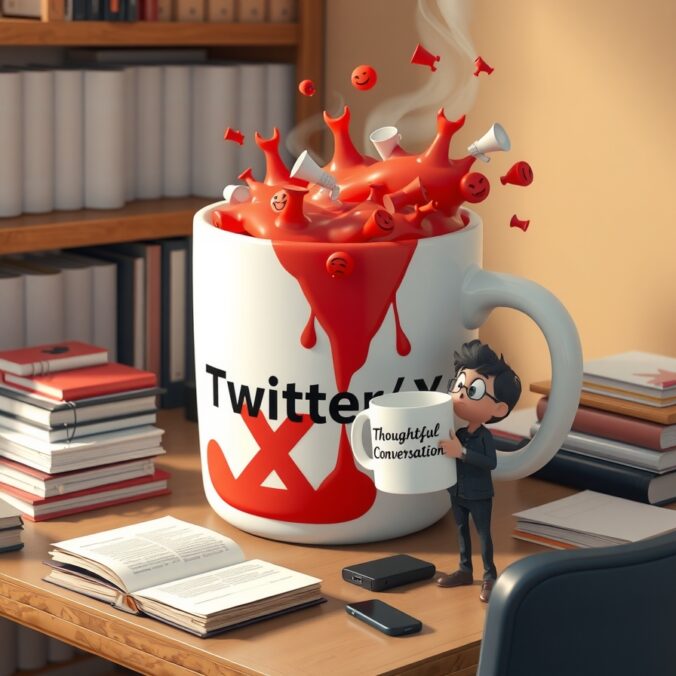I’d love to know the story why a high value url like Email.com sits unused. Surely some company has the capital to buy the url and redirect it to their own email platform. Gmail? Heck, it seems like just the thing Microsoft would do to boost traffic to Bing. Anyone know the story?
Category: Business (Page 1 of 24)
David Bayer, author and creator of “A Changed Mind,” has this simple formula I like:
Desire plus barrier removal equals desired outcome.
In plain English, most of us know what we want: more customers, more sales, more traction. But we forget the “barrier removal” part. And honestly, that’s where most marketing strategies get stuck.
Don’t Chase Shiny Objects Yet
It’s easy to think the next big thing will save the day. A TikTok campaign, a hot new CRM, some influencer deal. These things are cool to talk about at cocktail parties and networking events. (Plus, ad agencies will make you feel really special.) But truthfully, you don’t need another shiny object. You need to fix the stuff that’s already slowing people down.
Continue readingHook (3 seconds)
Most product messages fail because they start at the end. They lead with facts before earning the right to be heard. But people need something to grab their attention first.
Tease (30 seconds)
That’s why I work with something I call the 3-30-3 Rule. It isn’t a formula carved in stone, but a useful guide. The premise is simple:
Continue readingEarly in my career, I was a tactician. Email campaigns, SEO, SEM, building landing pages, hacking together A/B tests. Whatever the job needed, I’d figure it out.
Then I got older. Took on bigger roles. Strategy became my thing. I got an MBA, which basically teaches you how to never do real work again. Just make PowerPoints and use fancy terms like “ubiquitous” and “leveraging synergies.” Just kidding. Kind of.
Then I taught at UW. Strategy-heavy, theory-driven. But not much time for learning how to troubleshoot a broken Meta ad pixel or chase down why TikTok didn’t like the file format you uploaded.
Fast-forward to a recent client gig. A small, scrappy brand with big potential. I figured with AI at my side, I could go back to being a full-stack marketer. The headlines promised that AI was like hiring a 12-person team. All I had to do was show up and prompt. Well, that’s what I thought would happen…
Continue readingTL;DR Version
Twitter used to be a platform for discovery, curiosity, and real conversations. Over time, it shifted, to a space for customer complaints, then into a political battleground, and eventually into something stranger. Today, much of what passes for “debate” is driven by bots, automated replies, and talking points that feel like they were built in a conspiracy theory factory.
Research backs this up. Bots have been responsible for a disproportionate amount of political content for years, up to 30% or more, depending on the topic. The result is a platform where real engagement is harder to find, and actual people seem increasingly absent.
Continue readingResearch in psychology and psychiatry suggests that certain types of images or visual stimuli can help individuals improve focus and reduce distractions. These images often leverage principles of attention regulation, mindfulness, and environmental design. Here are a few scientifically-backed approaches:
1. Nature Scenes
- Why it works: Studies show that exposure to nature or even viewing images of natural environments can restore attention and reduce mental fatigue. This is based on the concept of Attention Restoration Theory (ART), which suggests that natural environments engage our attention in a gentle, involuntary way, allowing the directed attention system to rest.
- Example Images: Forests, flowing water, mountains, and greenery.
- Best Use: Displaying posters, screensavers, or paintings with calming natural scenes.
2. Abstract Art with Low Complexity
- Why it works: Complex or cluttered images can overstimulate individuals with ADHD, while simple, abstract designs or patterns can create a calming effect and reduce distractions.
- Example Images: Geometric patterns, smooth color gradients, or minimalist art with soft tones.
- Best Use: Use as background art in workspaces or as phone wallpapers.
3. Mandala Patterns
- Why it works: Mandalas and other symmetrical designs can promote mindfulness and focus through their repetitive and orderly structure. Some ADHD therapies include coloring mandalas to improve focus and reduce hyperactivity.
- Best Use: Use as interactive exercises (e.g., coloring apps) or as visual elements for meditation breaks.
4. Images with Blue and Green Hues
- Why it works: Blue and green are associated with calmness and focus. Research has shown that these colors can help regulate mood and improve attention span.
- Example Images: Ocean waves, clear skies, green fields.
- Best Use: Backgrounds for work environments or calming breaks.
5. Goal-Oriented Visuals
- Why it works: Visuals that represent goals, steps of a task, or progress can help individuals with ADHD stay task-oriented. Seeing a visual roadmap of their objectives can reduce the cognitive load and prevent distractions.
- Example Images: Infographics, step-by-step diagrams, or progress trackers.
- Best Use: Incorporate into task planning or to-do lists.
6. Soft Animated Visuals
- Why it works: Slow, non-distracting animations (like a gentle ocean wave or a flame flickering) can serve as a grounding point for focus. These animations are particularly useful for reducing anxiety and helping individuals stay engaged without overstimulation.
- Best Use: Display on digital devices or monitors as a background focus tool.
7. Visual Reminders of Break Spaces
- Why it works: Seeing a calming visual associated with a planned break (e.g., a peaceful garden or quiet reading corner) can create a mental cue for focused work until the break arrives.
- Example Images: Personalized images of a favorite relaxation spot or a digital timer with an image of the break area.
- Best Use: Use as desktop backgrounds or on task management tools.
As companies (like my clients) finalize their 2025 marketing strategies, many are asking whether LinkedIn still warrants a dedicated line in the budget. Once a critical space for B2B visibility and thought leadership, the platform now faces new competition, rising costs, and declining returns for some sectors. Plus, it seems like hardly anyone actually works there.
It seems like for every reason to keep it, there’s an equally valid one for abandoning it.
Read more: Does LinkedIn Still Belong in 2025 Marketing Budgets?Engagement Is Still Strong—But Flattening
For B2B marketers, LinkedIn has historically been unmatched in terms of audience intent. But engagement metrics suggest the platform may be nearing a plateau. According to LinkedIn’s own Benchmark Report, click-through rates on thought leadership posts declined year over year:
- 2023: 0.55%
- 2024: 0.49%
Meanwhile, a June 2024 Socialinsider study found carousel posts remained the most engaging format, especially for professional services firms. Short videos, once seen as a growth area, now underperform outside of HR or recruitment content.
The Cost Equation Is Shifting
Advertising on LinkedIn remains expensive—often prohibitively so for performance marketers. Wordstream’s Q3 2024 report shows stark differences in average CPM:
- LinkedIn: $38.12
- Meta (Facebook/Instagram): $14.74
- TikTok: $8.91
For campaigns focused on lead generation or direct conversions, the ROI may be difficult to justify compared to cheaper alternatives.
When LinkedIn Still Delivers
Despite those challenges, LinkedIn still drives value for certain brands—particularly those with high-ticket offerings or a professional audience. Sectors continuing to see returns include:
- SaaS and enterprise software
- Management consulting
- HR technology and recruiting firms
- Financial services
- Executive coaching and leadership training
These industries benefit from the trust and credibility that LinkedIn still holds with decision-makers.
For Consumer Brands, Less Justifiable
For lifestyle or direct-to-consumer brands, LinkedIn rarely makes sense. The professional context limits emotional storytelling, and users are less receptive to brand content unless it’s tied to employment, entrepreneurship, or career development.
Even brands experimenting with employer branding and culture posts are seeing limited traction unless the content is truly unique or backed by a hiring initiative.
A Tighter, Smarter Approach
LinkedIn isn’t dead, it just isn’t automatic. Marketers should reevaluate its role based on goals, cost, and audience fit. For brands that use it well, the platform can still offer high-quality engagement. For others, 2025 may be the right year to scale back and reinvest in channels with broader reach and better value.
I know you’re going to hate hearing this. I hate writing it. But if your brand still isn’t on TikTok as 2023 wraps up, you may be behind. This isn’t trend-chasing. We have to suck it up and go where attention lives. TikTok is shaping buying decisions across nearly every demographic, not just Gen Z.
1. People Are Spending Serious Time Here
TikTok now has over 1 billion monthly active users, and the average person spends about 95 minutes per day on the app. That’s more screen time than Netflix for some people (Saintnicks). And it’s not background noise. People are watching closely, not just scrolling past.
2. The Algorithm Works in Your Favor
You don’t need a huge follower count. TikTok’s algorithm recommends content based on what people like to watch, not who they follow. That gives smaller brands a legit shot to go big—even from zero. (Wikipedia – TikTok)
3. Low Budget, High Impact
You don’t need fancy gear or a studio. TikTok rewards authenticity. A founder talking to their phone camera can outperform a polished brand ad—if the message hits home (Third Wunder).
4. It’s Already Working for Small Businesses
This isn’t theory. One small brand boosted revenue by 1,650% after going viral on TikTok (Business Insider). TikTok itself reported $24.2 billion in economic activity from small businesses using the platform in 2023 (TikTok Newsroom).
5. TikTok Shop Removes Friction
Launched in September, TikTok Shop lets you sell right inside the app. No redirecting people to your website. No friction. You see it, you click it, you buy it (Wikipedia – TikTok Shop).
6. People Trust What They See
A TikTok study found that 92% of users who took action after watching a video said they did it because the content made them feel something. And 72% said they trust TikTok creators more than traditional ads (TikTok “What’s Next” report).
The Takeaway
TikTok isn’t just silly videos anymore. Used effectively, it can be a source of leads.
Title: Burnout, Bots, and Brand Trust: The Year Marketing Tried to Be Human Again
Published: January 2023
In 2022, marketing stopped trying to win the internet and started trying to win people back.
After a two-year sprint through pandemic pivots, remote chaos, and digital everything, the mood shifted. Customers were burned out. Teams were burned out. And somewhere in the noise, a quiet message emerged:
“Don’t try to be everywhere. Try to be real.”
It was the year of rebuilding brand trust. Of cutting through automation sludge. Of rethinking the funnel. And for many of us—of remembering why we got into this work in the first place.
Here’s what actually happened.
Consumer Behavior Changed—And Got More Selective
-
78% of consumers unfollowed brands in 2022 due to “inauthentic” messaging
(Source: Stackla, “Bridging the Gap” Report) -
Trust in social ads dropped for the third straight year—down to 43%, with Gen Z showing the sharpest decline
(Source: Edelman Trust Barometer) -
Email open rates held steady at 21.5%, but click-throughs declined by 5%
People opened out of habit, not curiosity. -
Reviews, UGC, and peer-led content outperformed branded ads in 73% of A/B tests
Trust shifted to real people, not stylized creatives.
We Over-Automated, Then Regretted It
-
Martech stack bloat peaked: the average mid-sized marketing team used 91 tools
(Source: ChiefMartec 2022) -
Chatbots replaced contact forms on 62% of B2C websites—but customer satisfaction dropped by 11%
The human touch was missed more than expected. -
AI-generated content became trendy—but conversion rates were 37% lower when used without human editing
You can’t automate authenticity.
What Did Work? Anything That Felt Human
-
Influencer marketing spend rose 42% year over year
Especially micro-creators (under 100K followers), who delivered better ROI and engagement. -
SMS campaigns saw a 35% click-through rate—with 98% open rates
Text isn’t dead. It’s just underused. -
Podcast ad revenue jumped to $2 billion, and listener trust remained higher than any digital format
People still like voices more than headlines. -
Brands that publicly admitted mistakes saw an 8% brand trust lift
Honesty scaled.
So What Do We Do With This?
The lesson of 2022 wasn’t “be everywhere.” It was:
Be somewhere real. With something worth saying. To people who might actually care.
We learned (again) that automation should support communication—not replace it. That being human still scales when done right. That trust still matters more than targeting.
And that the brands who won last year weren’t louder. They were clearer.
Five Takeaways From 2022
For CMOs, marketing leads, and teams who want to make smarter moves in 2023:
-
Cut your stack. Most teams don’t need 90 tools.
-
Edit your AI. Machine content is only as good as the human who sharpens it.
-
Trust is the new KPI. If your customers don’t believe you, your reach is meaningless.
-
Get personal again. SMS, podcasts, micro-creators—small formats built real engagement.
-
Real is rare. That’s why it still works.







